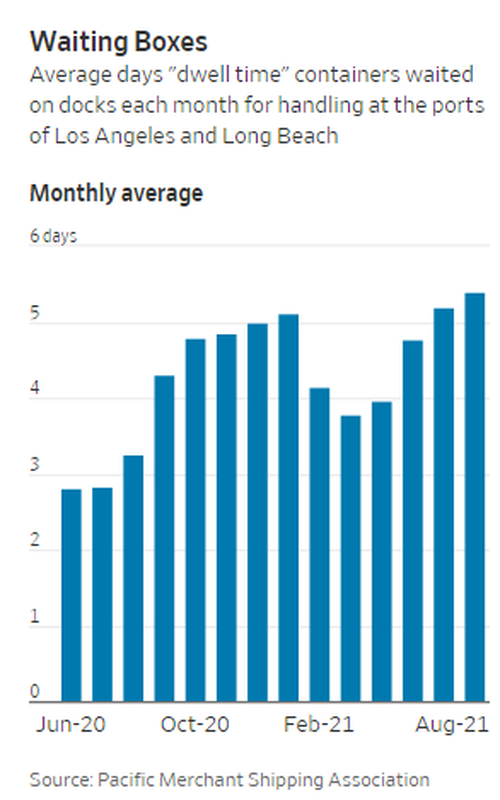(Il n'y a pas que les ports chinois qui sont saturés. note de rené)
Despite Record Cargo Backlogs, Ports Of L.A. And Long Beach Still Don't Operate Around The Clock (USA)
Some of the busiest U.S. ports, including many in California, are still struggling with how to deal with significant cargo backlogs.
Yet, despite the backlog, the busiest U.S. port still shuts down for hours on most days and is closed on Sundays, the Wall Street Journal reports. "Tens of thousands" of containers remain stuck at the ports of Los Angeles and Long Beach. More than 60 ships are lined up to dock, the report says.
More than 25% of all American imports pass through one of the two ports. LA and Long Beach collectively manage 13 private container terminals. Long Beach officials finally said last week they would try operating 24 hours a day between Monday and Thursday. LA says it's going to keep existing hours and wait for the rest of the supply chain to extend their hours first.
Gene Seroka, executive director of the larger Port of Los Angeles, said: “It has been nearly impossible to get everyone on the same page towards 24/7 operations.”
Ports in places like Asia and Europe, for contrast, have operated around the clock "for years", the report notes.
Uffe Ostergaard, president of the North America region for German boxship operator Hapag-Lloyd AG said: “With the current work schedule you have two big ports operating at 60%-70% of their capacity. That’s a huge operational disadvantage.”
As the shortage continues, all members of the supply chain including truckers, warehouse operators and railways, are blaming each other for the shortages of products. All parts of the supply chain are also struggling with a shortage of labor.
A longshore shift at either of the two ports used to be either 8AM to 4PM or 6PM to 3AM. Overnight shifts of 5 hours were "rarely used" because they are up to 50% more expensive, the report says.
The International Longshore and Warehouse Union says their members will work a third shift, but only after the pileup of containers is fetched out of the port so there is space.
Frank Ponce De Leon, a coast committeeman at the ILWU, said: “Congestion won’t be fixed until everyone steps up and does their part. The terminal operators have been underutilizing their option to hire us for the third shift.
Meanwhile, elsewhere in the supply chian, Federal safety regulations prevent commercial truck drivers to 11 hours of driving in a 14 hour workday. Port truckers like to start early in the morning so they can maximize the number of loads they can transport in a day.
Tom Boyle, chief executive of Quik Pick Express LLC, a trucking and warehousing provider, told the Journal: “The biggest issue it probably comes down to is labor.”
Rail operator Union Pacific says it sees most delays when it picks up cargo from ports and hands it to trucks at destinations.
Wim Lagaay, chief executive of APM Terminals North America, who operates at the port of LA, said: “If you work a gate 24/7 it will improve your velocity. Up to 30% of overall truck appointments are not met because there are not enough trucks, drivers or chassis.”
Matt Schrap, chief executive of the Harbor Trucking Association, added: “There is too much congestion from empty containers on terminals. The shipping lines aren’t moving the boxes out, which is preventing us from returning empties that we are storing in our yards."
Mario Cordero, executive director at the Port of Long Beach concluded: “It’s impossible to effectively move such volumes if we don’t move to 24/7 operations across the supply chain. They do it in other parts of the world.”


Aucun commentaire:
Enregistrer un commentaire